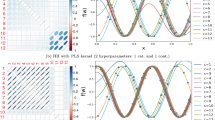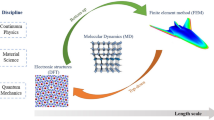Abstract
Determining process–structure–property linkages is one of the key objectives in material science, and uncertainty quantification plays a critical role in understanding both process–structure and structure–property linkages. In this work, we seek to learn a distribution of microstructure parameters that are consistent in the sense that the forward propagation of this distribution through a crystal plasticity finite element model matches a target distribution on materials properties. This stochastic inversion formulation infers a distribution of acceptable/consistent microstructures, as opposed to a deterministic solution, which expands the range of feasible designs in a probabilistic manner. To solve this stochastic inverse problem, we employ a recently developed uncertainty quantification framework based on push-forward probability measures, which combines techniques from measure theory and Bayes’ rule to define a unique and numerically stable solution. This approach requires making an initial prediction using an initial guess for the distribution on model inputs and solving a stochastic forward problem. To reduce the computational burden in solving both stochastic forward and stochastic inverse problems, we combine this approach with a machine learning Bayesian regression model based on Gaussian processes and demonstrate the proposed methodology on two representative case studies in structure–property linkages.











Similar content being viewed by others
References
N. Science, T.C. (US), Materials Genome Initiative for Global Competitiveness. Executive Office of the President, National Science and Technology Council (2011).
A. Agrawal and A. Choudhary, APL Mater. 4(5), 053208 (2016).
S.R. Kalidindi, A.J. Medford, and D.L. McDowell, JOM 68(8), 2126 (2016).
D.L. McDowell, JOM 59(9), 21 (2007).
J.H. Panchal, S.R. Kalidindi, and D.L. McDowell, Comput. Aided Des. 45(1), 4 (2013).
P. Honarmandi and R. Arróyave, Integr. Mater. Manuf. Innov. 1–41 (2020).
P. Fernandez-Zelaia, Y.C. Yabansu, and S.R. Kalidindi, Integr. Mater. Manuf. Innov. 8(2), 67 (2019).
A. Paul, P. Acar, Wk Liao, A. Choudhary, V. Sundararaghavan, and A. Agrawal, Comput. Mater. Sci. 160, 334 (2019).
L. Johnson and R. Arróyave, Mater. Des. 107, 7 (2016).
M. Yuan, S. Paradiso, B. Meredig, and S.R. Niezgoda, Integr. Mater. Manuf. Innov. 7(4), 214 (2018).
M. Diehl, M. Groeber, C. Haase, D.A. Molodov, F. Roters, and D. Raabe, JOM 69(5), 848 (2017).
W. Liu and J. Lian, Proc. Manuf. 47, 1552 (2020).
W. Liu, J. Lian, N. Aravas, and S. Münstermann, Int. J. Plast. 126, 102614 (2020).
M. Diehl, J. Niehuesbernd, and E. Bruder, Metals 9(12), 1252 (2019).
A.E. Tallman, K.S. Stopka, L.P. Swiler, Y. Wang, S.R. Kalidindi, and D.L. McDowell, JOM 71(8), 2646 (2019).
A.E. Tallman, L.P. Swiler, Y. Wang, and D.L. McDowell, Comput. Methods Appl. Mech. Eng. 365, 113009 (2020).
R. Liu, Y.C. Yabansu, A. Agrawal, S.R. Kalidindi, and A.N. Choudhary, Integr. Mater. Manuf. Innov. 4(1), 13 (2015).
R. Liu, Y.C. Yabansu, Z. Yang, A.N. Choudhary, S.R. Kalidindi, and A. Agrawal, Integr. Mater. Manuf. Innov. 6(2), 160 (2017).
A. Pandey and R. Pokharel, Machine learning enabled surrogate crystal plasticity model for spatially resolved 3D orientation evolution under uniaxial tension. arXiv:2005.00951 (2020).
Z. Yang, Y.C. Yabansu, D. Jha, Wk Liao, A.N. Choudhary, S.R. Kalidindi, and A. Agrawal, Acta Mater. 166, 335 (2019).
Z. Yang, R. Al-Bahrani, A.C. Reid, S. Papanikolaou, S.R. Kalidindi, W.k. Liao, A. Choudhary, and A. Agrawal, Deep learning based domain knowledge integration for small datasets: illustrative applications in materials informatics. in 2019 International Joint Conference on Neural Networks (IJCNN). (IEEE, 2019), p. 1–8.
Z. Yang, Y.C. Yabansu, R. Al-Bahrani, Wk Liao, A.N. Choudhary, S.R. Kalidindi, and A. Agrawal, Comput. Mater. Sci. 151, 278 (2018).
Z.L. Wang and Y. Adachi, Mater. Sci. Eng. A 744, 661 (2019).
P. Acar, S. Srivastava, and V. Sundararaghavan, AIAA J. 55(9), 3161 (2017).
H.J. Choi, D.L. Mcdowell, J.K. Allen, and F. Mistree, Eng. Optim. 40(4), 287 (2008).
B.D. Ellis and D.L. McDowell, Integr. Mater. Manuf. Innov. 6(1), 9 (2017).
D.L. McDowell, J. Panchal, H.J. Choi, C. Seepersad, J. Allen, and F. Mistree, Integrated Design of Multiscale, Multifunctional Materials and Products (Butterworth-Heinemann, Oxford, 2009).
M. Groeber, S. Ghosh, M.D. Uchic, and D.M. Dimiduk, Acta Mater. 56(6), 1257 (2008).
M. Groeber, S. Ghosh, M.D. Uchic, and D.M. Dimiduk, Acta Mater. 56(6), 1274 (2008).
R. Bostanabad, Y. Zhang, X. Li, T. Kearney, L.C. Brinson, D.W. Apley, W.K. Liu, and W. Chen, Prog. Mater. Sci. 95, 1 (2018).
S. Torquato, Annu. Rev. Mater. Res. 32(1), 77 (2002).
S. Bargmann, B. Klusemann, J. Markmann, J.E. Schnabel, K. Schneider, C. Soyarslan, and J. Wilmers, Prog. Mater. Sci. 96, 322 (2018).
Y. Liu, M.S. Greene, W. Chen, D.A. Dikin, and W.K. Liu, Comput. Aided Des. 45(1), 65 (2013).
A. Tran and H. Tran, Acta Mater. 178, 207 (2019).
M.A. Groeber and M.A. Jackson, Integr. Mater. Manuf. Innov. 3(1), 5 (2014).
F. Roters, M. Diehl, P. Shanthraj, P. Eisenlohr, C. Reuber, S.L. Wong, T. Maiti, A. Ebrahimi, T. Hochrainer, H.O. Fabritius, et al. Comput. Mater. Sci. 158, 420 (2019).
F. Roters, P. Eisenlohr, C. Kords, D. Tjahjanto, M. Diehl, and D. Raabe, Procedia Iutam 3, 3 (2012).
F. Roters, Advanced material models for the crystal plasticity finite element method: development of a general CPFEM framework. Ph.D. thesis (RWTH Aachen University, 2011).
F. Roters, P. Eisenlohr, T.R. Bieler, D. Raabe, Crystal Plasticity Finite Element Methods: In Materials Science and Engineering (Wiley, New York, 2011).
F. Roters, P. Eisenlohr, L. Hantcherli, D.D. Tjahjanto, T.R. Bieler, and D. Raabe, Acta Mater. 58(4), 1152 (2010).
M. Diehl, A spectral method using fast Fourier transform to solve elastoviscoplastic mechanical boundary value problems.
H.F. Alharbi and S.R. Kalidindi, Int. J. Plast. 66, 71 (2015).
P. Eisenlohr, M. Diehl, R.A. Lebensohn, and F. Roters, Int. J. Plast. 46, 37 (2013).
P. Shanthraj, P. Eisenlohr, M. Diehl, and F. Roters, Int. J. Plast. 66, 31 (2015).
S. Abhyankar, J. Brown, E.M. Constantinescu, D. Ghosh, B.F. Smith, and H. Zhang, PETSc/TS: a modern scalable ODE/DAE solver library. arXiv:1806.01437 (2018).
S. Balay, S. Abhyankar, M. Adams, J. Brown, P. Brune, K. Buschelman, L. Dalcin, A. Dener, V. Eijkhout, W. Gropp, et al. PETSc users manual (2019).
B. Shahriari, K. Swersky, Z. Wang, R.P. Adams, and N. de Freitas, Proc. IEEE 104(1), 148 (2016).
A. Tran, M. Eldred, Y. Wang, S. McCann, srMO-BO-3GP: a sequential regularized multi-objective constrained Bayesian optimization for design applications, in Proceedings of the ASME 2020 IDETC/CIE, International Design Engineering Technical Conferences and Computers and Information in Engineering Conference, vol. Volume 1: 40th Computers and Information in Engineering Conference (American Society of Mechanical Engineers, 2020).
A. Tran, S. McCann, J.M. Furlan, K.V. Pagalthivarthi, R.J. Visintainer, T. Wildey, and M. Eldred, aphBO-2GP-3B: a budgeted asynchronous-parallel multi-acquisition for known/unknown constrained Bayesian optimization on high-performing computing architecture. arXiv:2003.09436 (2020).
A. Tran, J. Sun, J.M. Furlan, K.V. Pagalthivarthi, R.J. Visintainer, and Y. Wang, Comput. Methods Appl. Mech. Eng. 347, 827 (2019).
C.E. Rasmussen, Gaussian Processes in Machine Learning (MIT Press, Cambridge, 2006).
T. Butler, J. Jakeman, and T. Wildey, SIAM J. Sci. Comput. 40(2), A984 (2018).
T. Butler, J. Jakeman, and T. Wildey, SIAM J. Sci. Comput. 40(5), A3523 (2018).
T. Butler, T. Wildey, and T.Y. Yen, Inverse Problems (2020).
D.R. Steinmetz, T. Jäpel, B. Wietbrock, P. Eisenlohr, I. Gutierrez-Urrutia, A. Saeed-Akbari, T. Hickel, F. Roters, and D. Raabe, Acta Mater. 61(2), 494 (2013).
S.L. Wong, M. Madivala, U. Prahl, F. Roters, and D. Raabe, Acta Mater. 118, 140 (2016).
S.R. Kalidindi, J. Mech. Phys. Solids 46(2), 267 (1998).
W. Blum and P. Eisenlohr, Mater. Sci. Eng. A 510, 7 (2009).
J.W. Hutchinson, Proc. R. Soc Lond. A Math. Phys. Sci. 348(1652), 101 (1976).
F. Han, M. Diehl, F. Roters, and D. Raabe, J. Mater. Process. Technol. 277, 116449 (2020).
M. Wicke and A. Brueckner-Foit, Mixed-mode crack tip fields in a polycrystalline aluminum alloy, in MATEC Web of Conferences, vol. 300 (EDP Sciences, 2019), p. 11004.
Z. Zhao, M. Ramesh, D. Raabe, A. Cuitino, and R. Radovitzky, Int. J. Plast. 24(12), 2278 (2008).
A.V. Tran, D. Liu, H.A. Tran, and Y. Wang, Modell. Simul. Mater. Sci. Eng. 27(6), 064005 (2019).
A. Tran, J. Tranchida, T. Wildey, and A.P. Thompson, J. Chem. Phys. 153, 074705 (2020).
A. Tran, T. Wildey, and S. McCann, sBF-BO-2CoGP: a sequential bi-fidelity constrained Bayesian optimization for design applications, in Proceedings of the ASME 2019 IDETC/CIE, International Design Engineering Technical Conferences and Computers and Information in Engineering Conference, vol. Volume 1: 39th Computers and Information in Engineering Conference. (American Society of Mechanical Engineers, 2019). V001T02A073.
A. Tran, T. Wildey, and S. McCann, J. Comput. Inform. Sci. Eng. 20(3), 1 (2020).
A. Tran, J.A. Mitchell, L.P. Swiler, and T. Wildey, Acta Mater. 194, 80 (2020).
Acknowledgements
The views expressed in the article do not necessarily represent the views of the US Department of Energy or the US Government. Sandia National Laboratories is a multimission laboratory managed and operated by National Technology and Engineering Solutions of Sandia, LLC., a wholly owned subsidiary of Honeywell International, Inc., for the US Department of Energy’s National Nuclear Security Administration under Contract DE-NA-0003525. This research was supported by the US Department of Energy, Office of Science, Early Career Research Program.
Funding
This research was supported by the US Department of Energy, Office of Science, Early Career Research Program.
Author information
Authors and Affiliations
Corresponding author
Additional information
Publisher’s Note
Springer Nature remains neutral with regard to jurisdictional claims in published maps and institutional affiliations.
Rights and permissions
About this article
Cite this article
Tran, A., Wildey, T. Solving Stochastic Inverse Problems for Property–Structure Linkages Using Data-Consistent Inversion and Machine Learning. JOM 73, 72–89 (2021). https://doi.org/10.1007/s11837-020-04432-w
Received:
Accepted:
Published:
Issue Date:
DOI: https://doi.org/10.1007/s11837-020-04432-w




